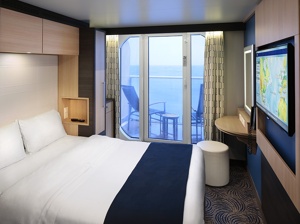Max out memories onboard Ovation of the Seas®, one of the world's most groundbreaking ships.
Go scenery scoping from the North Star®, the highest vantage point on any cruise ship — or head to the SeaPlex® to rev up your family time. Spend the afternoon whizzing around a roller-skating arena with your adventure crew, then challenge them to a game of bumper cars or basketball for bragging rights. When you're ready to refuel, let your appetite lead you into any of the 17 unforgettable eateries awaiting you on board. Only on Royal Caribbean — the cruise line voted Best Overall for 21 years running by Travel Weekly readers.
Cruise ID: 33111
The automatic service gratuity of $18.00 USD per person, per day for guests in non-suites staterooms and Junior Suite, or $20.50 USD per person, per day for guests in Suites, will be applied to each guest's SeaPass account on a daily basis. The gratuity applies to individual guests of all ages and stateroom categories. As a way to reward our crew members for their outstanding service, gratuities are shared among dining, bar & culinary services staff, stateroom attendants and other hotel services teams who work behind the scenes to enhance the cruise experience.
In the unlikely event that a guest onboard being charged the daily automatic gratuity does not receive satisfactory service, the guest may request to modify the daily amount at their discretion by visiting Guest Services onboard and will be able to do so until the morning of their departure. Guests who have pre-paid their gratuity will not see a daily charge during their cruise.
The automatic daily gratuity is based on customary industry standards. Applying this charge automatically helps streamline the recognition process for the crew members who work to enhance your cruise. We hope you find the gratuity to be an accurate reflection of your satisfaction and thank you for your generous recognition of our staff.
A 18% gratuity is automatically added to all beverages and mini bar items.
A 20% gratuity is automatically added to all spa & salon purchases.
Guests can pre-pay gratuities by calling (UK) 0344 493 4005 / (Ireland) 1800 555 604 or logging into www.royalcaribbean.co.uk before* their sailing. For guests booked through travel advisors, their advisor may add pre-paid gratuities to the guests' booking prior to sailing*. If gratuities are not prepaid prior to sailing, they will be automatically added to the guests' folios once onboard.
Guests who choose ‘My Time Dining' on all European sailings will have gratuities automatically added to their bill, as they may be served by different members of the team each night. This means tips for your waiting staff – as well as other dining and housekeeping staff – will be included in the quoted price for ‘My Time Dining' on your cruise holiday
Guests who choose our open dining option may opt-in to pre-paid gratuities for dining, or add them to their account at check-out.
*Pre-paid gratuities can be added to an individual reservation at any time outside of 48 hours of the sail date.

































